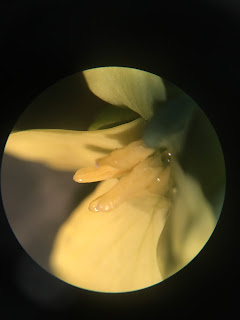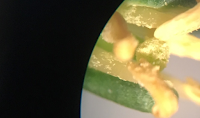While many different parts of the plant had their own variations, the leaves and the stem of the brassica oleracea looked to have the greatest amount of diversity throughout the different plants. While the plants varied in size considerably, the plants are in different stages of their development, so the sizes do not show as much fluctuation as it may seem. The plants we measured ranged from ⅞ of an inch up to just over 6 inches in width, and from just over 3 inches to 7 inches. The plants also varied in areas such as texture, color, and shape. Some of the different species of brassica had pointed, ridged, or even rounded edges to create a unique shape for each plant. Some plants were a deep green color, while others had an infusion of purple in the leaf. Textures of the leaves included smooth, wrinkly, and waxy.
2 Using the terms that follow, explain why you think there is so much variability in the domestic forms of brassica oleracea: traits, selective breeding, artificial selection, genes, descent with modification, natural variations, mutations
There is so many differences in the traits of Brassica because of selective breeding. Over several generations this process, also called artificial selection, which is where a person over several hundreds years chooses the natural variations from each plant and only lets those specific plants to breed. The changes that each plant acquires over time represents descent with modification. This is significant because mutations that are favored become most common genes in the gene pool.
3.Which part (anatomy) of the Brassica oleracea plants seems to be most consistently the same in all of the examples in our garden, regardless of how extreme the differences between other parts of the same plants may be? Why do think this is so? Again, use and include data collected from multiple measurements to support your answer.
The part of the Brassica Oleracea that seemed to have a common resemblance throughout the garden were the flowers. All of them had an unmistakable yellow coloring, and were anywhere from ¾ of an inch to an inch. I did some extra research on brassica plants to back this up, and I discovered many do have these same features. This is most likely because the flowers are probably not a main priority for breeders while the plants are going through artificial selection. These growers are most likely worrying about leave size, taste, and growth rates among many things. In result, the flowers were practically left unchanged and may be the same as the flowers of brassicas thousands of years ago.
4 What would plant breeders have to do in order to get the body part or characteristic you described above (in your response to question #3) to become much different than it is presently?
If plant breeders wanted to modify these brassica they would have to selectively breed the plants based on the flowers. Then, the growers would have to reproduce brassica plants until they found a plant with different flowers in anyway. They then would breed the plant with more plants like it and pick the respective plant with even more change. Then they would repeat this process multiple times, and ultimately the flowers would end up looking very different from how they looked at the start. This recurring process is the same one used to raise close to every plant.






